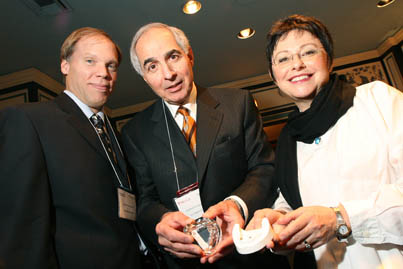RESEARCH & DISCOVERIES
No more slip-sliding away
Dental implants give patients more bite

Dr Pierre Boudrias, professor of prosthodontics at the Université de Montréal, and McGill's Dr Robert David, director of continuing education for graduate dentists, and Dr Jocelyne Feine, director, graduate studies in dental sciences, at the recent Implant Extravaganza.
Owen Egan
The problem with traditional dentures is that because they are held in place by little more than a dab of gluey gel, they slip and slide at the most inopportune times. Rather than deal with the aggravation and embarrassment of teeth that pop out mid-burger, denture wearers gradually stop eating certain foods. "These people often migrate towards softer, less nutritious and less fibrous foods," said Dr. Robert David, the director of continuing education for graduate dentists at McGill and the organizer of the recent Implant Extravaganza dental conference. "It has a negative impact on their health."
Implant technology has the potential to change all that. Securing tiny titanium implants into the bony ridge where teeth were once rooted, dentists can bolt crowns and other bridgework to a patient's mouth, forever eliminating the dissatisfaction of conventional dentures. But as remarkable as implants are, their hefty price tag, which can run several thousand dollars apiece, means that only the very wealthy can afford the four or five implants frequently used to secure tooth replacements to the lower jaw. While in some countries, such as the Netherlands, the government sees fit to subsidize basic implant work, here in Canada federal and provincial governments have been slower to embrace the technology.
Life-changing procedure
Enter Dr. Jocelyne Feine, director, graduate studies in dental sciences at McGill. Four years ago, she began a study of the health benefits derived from a single denture being secured to just two implants secured to the front of the jaw bone — a system that some practitioners looked at skeptically because they believed that a more complex method of implants was needed to create a secure fit. "If you've got a population that has a great need and few resources, you've got to find the least costly, most effective treatment." In Quebec, where some 58 percent of people 60 years and older no longer have their own teeth, the time was ripe for action.
Feine's team took 254 elderly volunteers and gave half of them the two-implant system and the other half conventional dentures. Following both groups, her initial findings indicate that the diets and nutritional health of the implant group have improved significantly. "We hope to demonstrate that people with two implants will live longer and require less assisted living. Hopefully, governments and insurance companies will see that they can save more money later by spending a little money up front."
Charles Poulin, a participant in Feine's study, received his two implants three years ago. The difference in his life, he said, is night and day. "There is nothing more beautiful than biting into a nice, crisp apple," he beamed. "I wake up every morning with a beautiful smile — I smile even when I sleep because I'm so happy."
Lise Deschesnes, another implant recipient from Feine's study, echoed the sentiment. "The implants have changed my life," she said. "I only hope they continue with studies like this one so that, one day, everyone can benefit."

